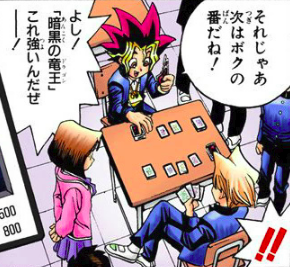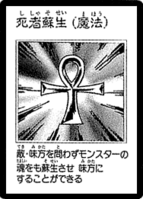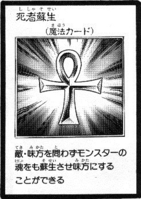Duel Monsters (manga)
Duel Monsters, known as Magic & Wizards (マジック
This is the very first incarnation of Duel Monsters and served as the basis for many of the variations to follow, including the Yu-Gi-Oh! Official Card Game and Yu-Gi-Oh! Trading Card Game.
Duel Monsters debuted when the manga had an episodic format and featured a different game nearly every week. However due to its popularity among readers, it ended up becoming the main game played throughout the series.
Contents
Name
The game is called Magic & Wizards or M&W for short in the Japanese manga. However, due to its similarity to Magic: The Gathering, the game was renamed to Duel Monsters in other media. Despite this, the Japanese manga continued to call the game Magic & Wizards throughout its run.
When the English manga was first printed in the Shonen Jump magazine, it used the name Magic and Wizards.[1] However when those chapters were reprinted in volumes, the name was changed to Duel Monsters.
Cards
Layout
The layout of the cards is simplistic compared to other iterations of the game. All cards are white with black border around them. While concepts like Attribute and Type exist, they are not reflected on the card's layout. Sometimes cards have effects not printed on them, such as "Time Wizard".
The rules on the placement of elements on a card are not strictly enforced. The rules below are generally followed, but numerous exceptions exist.
Initially the layout consisted of the following in this order:
- The card name
- For non-Monster Cards, the card's type appeared in brackets after the name. This did not include the word "Card". e.g. a Spell Card would say "(Spell)", not "(Spell Card)".
- For Monster Cards, a number of stars indicating the Level appeared on the same row as the name or the next row, depending on space.
- The card's artwork, surrounded by a border.
- For Monster Cards, a row with the word "ATK" (
攻 撃 力 ), followed by the ATK value and a row with the word "DEF" (守 備 力 ), followed by the DEF value. - Text for the card's effect
- If a Monster Card has an effect, its ATK and DEF are put on the same row, making space for the effect to be printed above them.
- Card's have a prismatic corner stamp, but these are not visible to the reader.[1]
Beginning with "Challenge!!", the layout changed a bit:
- The word "Card" appears after the card type. e.g. "(Spell Card)". The card type is completely omitted for a number of cards.
- Level and card type are more frequently placed on the line after the name.
- On Monster Cards, the card's effect is placed above ATK and DEF.
Rules
Basic
In the first set of rules:
- There are two players in each Duel.[1]
- Each player makes a Deck using 40 cards.[1] The Decks are shuffled before a Duel.[2]
- There are two kinds of cards; Monster Cards and Spell Cards.[3]
- Each player starts with 2000 Life Points. If a player runs out of Life Points they lose.[1]
- At the beginning of a Duel, each player draws five cards, which become their hand.[4]
- The players take turns. Each turn the turn player draws one card from their Deck.[1]
- The turn player can Summon cards from their hand in Attack or Defense Mode.[1] Attack Mode is vertical. Defense Mode is horizontal.[3]
- The turn player can attack with Attack Mode monsters.[3]
- If an Attack Mode monster battles another Attack Mode monster, the monster with the lower ATK is destroyed and its controller loses Life Points equal to the difference.[3]
- When Attack Mode monsters with equal ATK battle, both are destroyed.
- If an Attack Mode monster attacks a Defense Mode monster and its ATK is higher than the defending monster's DEF, the defending monster is destroyed and no Life Points are lost.[3]
- If an Attack Mode monster attacks a Defense Mode monster and its ATK is lower than the defending monster's DEF, neither monster is destroyed and the controller of the attacking monster loses Life Points equal to the difference in the ATK and DEF.[3]
- If a player does not have a monster to defend from their opponent's monsters attack, the monster's ATK is deducted from the defenseless player's Life Points.[1]
- Destroyed cards go to the Graveyard.[3]
- The turn player can activate Spell Cards from their hand.[4]
- Spell Cards cannot battle, but can be used to affect other cards or the players.[3]
- Spell Cards can be played face-down on the field until they are ready to be used.[3]
- Monsters with the power of flight have a 35% chance to evade ground-based attacks, allowing them to avoid being destroyed when battling monsters with the same ATK.[4]
History
Duel Monsters was a big hit in the United States and started to gain a following in Japan too.[1]
The game featured a number of valuable cars, with one fan in America alleged to have sold his house to pay for a single card. Initially "Blue-Eyes White Dragon" was considered to be one of the most powerful cards, so overpowered that production was ceased, causing it to gain a high monetary among collectors.[1] Four copies were known to exist. They fell into the hands of collectors in the United States, Germany, and Hong Kong and Sugoroku Mutou in Japan.[5]
Seto Kaiba's attempt to steal the "Blue-Eyes White Dragon" from Sugoroku Mutou resulted in him being challenged to a Shadow Game of Duel Monsters by Dark Yugi. In this game, the monsters came to life as they were Summoned.[1] On defeat, Kaiba was subjected to a Penalty Game, resulting in him imagining he was trapped inside a card, causing him to reside in the World of Duel Monsters, where he suffered the Experience of Death at the hands of monsters.[3]
Kaiba invented the Solid Vision technology and Battle Boxes, which created 3-D simulations of cards, as players played Duel Monsters, recreating what he witnessed in the Shadow Game. And allowed him to inflict a reconstruction of the Experience of Death on the loser.[5]


